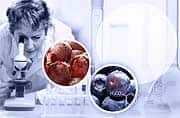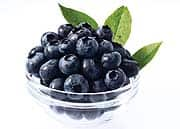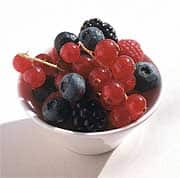Life Extension Magazine®
Scientists have discovered a plant extract related to resveratrol that mimics many of the beneficial effects of caloric restriction. This natural compound favorably regulates genes involved in the development of cancer, atherosclerosis, diabetes, and the system-wide inflammation that underlies a variety of age-related disorders. Pterostilbene (terro-STILL-bean), found in blueberries, grapes, and in the bark of the Indian Kino Tree, has been used for centuries in Ayurvedic medicine. Pterostilbene and resveratrol are both stilbene compounds, closely related structurally, which gives them similar but not identical functions. Researchers have found that these two compounds work in a synergistic fashion to activate one’s “longevity genes.” Pterostilbene produces its beneficial effects on gene expression in ways that enhance those produced by resveratrol. That is why pterostilbene functions particularly well when combined with resveratrol. This article first examines the unique ways in which pterostilbene simulates conditions produced by caloric restriction. Then it will describe how these effects translate into a broader spectrum of benefits than otherwise provided by resveratrol alone. Pterostilbene and Gene Expression: The Key to Longer LifeYou’re probably used to thinking of genes as fixed units of hereditary information that determine physical characteristics like hair and eye color. Scientists now know that you can change the messages your genes transmit to your body. This process is known as gene expression. It occurs when stimuli from within or outside your body switch certain genes “on” or “off.” Switching on protective genes or switching off harmful ones (modulating gene expression) is one of the most exciting areas of medical research. Calorie restriction turns on genes directly related to long term survival. This includes genes that reduce the activity of certain cancer-promoting agents, genes that induce programmed death of cancer cells, and genes that confer neuroprotection.1 The incredible news is that many of the same genes that confer a longer life span can be favorably modulated with plant extracts such as resveratrol and pterostilbene. How Pterostilbene and Resveratrol Work Together
Scientists have found that resveratrol activates genes near the beginning of the molecular cascade precipitated by caloric restriction. These in turn activate a broad array of disease-preventing genes. In essence, resveratrol’s beneficial genetic action takes place “upstream.” Pterostilbene directly activates genes “downstream” from the sites of resveratrol’s action. This complements resveratrol’s ability to help prevent cancer and diabetes, and support healthy blood lipids. Acting together, resveratrol and pterostilbene produce potent longevity-promoting effects across the cycle of gene expression through complementary mechanisms. How Pterostilbene Mimics Caloric RestrictionIt’s truly remarkable how closely pterostilbene can mimic the beneficial effects of calorie restriction on a molecular level. Calorie restriction directly suppresses cancer-causing genes while up-regulating genes that suppress cancer development.1-21 In numerous studies pterostilbene modulates exactly the same genes, up-regulating those that stimulate the programmed cell death known as apoptosis, and down-regulating those that allow cancer cells to invade and metastasize.22-31 Calorie restriction changes expression of genes throughout the metabolic process. It increases activity of powerful fat-sensing complexes that lower blood lipids and sugar levels.32-35 Pterostilbene naturally activates these same fat-sensing complexes and was found to favorably affect lipid profiles in hamsters with elevated cholesterol.36,37 In the liver, calorie restriction favorably modifies several vital glucose-regulating enzymes, which helps to control blood sugar.38 Pterostilbene produces identical beneficial changes in many of those enzymes. It also reduces markers of dangerous glucose-damaged proteins (glycosylated hemoglobin).39 Calorie restriction dramatically reduces production of inflammatory mediators linked to age-related conditions such as atherosclerosis, chronic inflammatory diseases, and even cognitive decline.8,40-51 At the level of gene expression, pterostilbene exerts virtually identical effects, suppressing those same genes in studies of inflammation-related conditions.23,31,52-54 And like calorie restriction, pterostilbene up-regulates specific brain proteins associated with improved memory.55,56 Cancer ChemopreventionThere’s growing evidence that pterostilbene provides chemoprevention by many routes. Pterostilbene has powerful antioxidant capacity equivalent to resveratrol, and its anti-inflammatory actions help it block the inflammation/cancer connection.57 In addition, pterostilbene inhibited the growth of highly malignant human melanoma cells and prevented metastatic spread of those cells to the liver in laboratory animals. It thus enhanced survival.27 As with so many nutraceuticals, pterostilbene achieved this dramatic effect by multiple mechanisms. It inhibits production of molecules that cancer cells use to “stick” to vessel walls, and also makes them vulnerable to immune-system destruction. Other mechanisms include: blocking enzymes that activate carcinogens;58,59 up-regulating pro-apoptotic activity in highly resistant leukemia cells (while showing no toxicity at all to normal blood-forming cells);29 blocking metastatic spread of aggressive and invasive human breast cancer cells;25 and enhancing nitric oxide-induced cell death in human melanoma.28 At the whole-organism level, pterostilbene suppresses formation of pre-cancerous cells in the colons of carcinogen-exposed animals.60 More excitingly, pterostilbene and quercetin dramatically enhanced elimination by radiation and chemotherapy treatment of implanted colon cancers.54 Cancer cells communicate with each other across special connectors called gap junctions. Pterostilbene disrupts those gap junctions, thereby interfering with inter-cellular communication that cancers need to direct their renegade growth.60-61 Disruption of gap junctions is a mechanism that appears to be truly unique to pterostilbene, one not shared by other chemopreventive or chemotherapy agents. Clearly there’s substance to the recent conclusion by Korean cancer researchers that “pterostilbene may be a functional chemopreventative agent and that dietary exposure of pterostilbene would be helpful for improving health.” 24 Cognition and MemoryBoth resveratrol and pterostilbene have remarkable effects on learning and memory. Pterostilbene was the most efficacious of a group of resveratrol-like compounds at preventing loss of the neurotransmitter dopamine from memory centers in aged rats.62 Supplementation with pterostilbene reversed cognitive behavioral deficits. This study showed working memory function was correlated with levels of pterostilbene in the hippocampus, a key brain location where memory is processed.
A closer look reveals yet again the astonishing correspondence between pterostilbene and caloric restriction on gene expression. Supplementation with blueberries (one of the richest sources of pterostilbene) improved performance of aged animals in working memory after just three weeks.55 The improvement was closely correlated with activation of a brain-signaling protein in the hippocampus. Improvement in memory performance was just recently shown to be another direct result of caloric restriction!56 Improved spatial memory during times of low food availability might be a very appropriate adaptive response, making animals more efficient at locating scarce food resources. If so, then pterostilbene’s ability to mimic these fundamental changes in brain chemistry is a powerful modern take on an ancient survival mechanism. Pterostilbene affects gene expression similarly to caloric restriction in multiple ways … all key in the battle against age-related disease. A more in-depth report about pterostilbene’s many health benefits will be included in the February 2010 edition of Life Extension Magazine®. SummaryIn the words of Dr. Agnes M. Rimando, a leading expert in the biology of the stilbenes (resveratrol, pterostilbene, and related compounds): “Stilbenes have diverse pharmacological activities, which include cancer prevention, a cholesterol-lowering effect, enhanced insulin sensitivity, and increased life span.”63 What is so exciting to modern researchers is the way in which both resveratrol and pterostilbene achieve these benefits by mimicking the actions of caloric restriction, which produces similar effects on gene expression. Even more exciting is the series of discoveries showing that resveratrol and pterostilbene produce similar results by acting at different locations in the control of gene expression. This means that these two phytonutrients likely complement one another in increasing both the quantity and the quality of life. Along with responsible calorie control and exercise, both belong in the regimens of people who are serious about improving health and longevity. To find out how much pterostilbene you may need, please read below.
If you have any questions on the scientific content of this article, please call a Life Extension Wellness Specialist at 1-800-226-2370. |
||||||
| References | ||||||
|
1. Expert Opin Ther Pat. Apr 2009;19(4):403-14. 2. Toxicol Sci. Oct 2002;69(2):448-59. 3. Exp Gerontol. Aug-Sep 2002;37(8-9):1041-53. 4. FASEB J. Nov 2005;19(13):1863-5. 5. Antioxid Redox Signal. Mar-Apr 2006;8(3-4):671-80. 6. Biochem J. Aug 1 2006;397(3):519-27. 7. J Gerontol A Biol Sci Med Sci. Jan 2007;62(1):18-26. 8. Inflamm Res. Mar 2009;58(3):143-50. 9. FEBS Lett. Jul 9 2008;582(16):2417-23. 10. Arterioscler Thromb Vasc Biol. Jun 2009;29(6):889-94. 11. J Gerontol A Biol Sci Med Sci. Jul 2009;64(7):711-22. 12. Cancer Lett. Jun 3 1997;116(1):61-9. 13. J Gerontol A Biol Sci Med Sci. May 1998;53(3):B168-72. 14. Chin Med Sci J. Dec 2000;15(4):226. 15. Microsc Res Tech. Nov 15 2002;59(4):282-92. 16. Physiol Rev. Jul 2002;82(3):637-72. 17. Neurobiol Aging. Sep-Oct 2002;23(5):695-705. 18. Science. Jul 16 2004;305(5682):390-2. 19. Exp Gerontol. Sep 2004;39(9):1361-8. 20. Cancer Res. Feb 15 2004;64(4):1541-5. 21. J Mol Cell Cardiol. Mar 2009;46(3):405-12. 22. J Agric Food Chem. Sep 19 2007;55(19):7777-85. 23. J Agric Food Chem. Aug 27 2008;56(16):7502-9. 24. Food Chem Toxicol. Feb 2009;47(2):404-9. 25. Evid Based Complement Alternat Med. 2009 Jul 16. 26. Cancer Prev Res (Phila Pa). Jul 2009;2(7):650-7. 27. Neoplasia. Jan 2005;7(1):37-47. 28. J Biol Chem. Feb 2 2007;282(5):2880-90. 29. Int J Biochem Cell Biol. Aug 2005;37(8):1709-26. 30. BMC Med Genomics. 2008;1:7. 31. Carcinogenesis. Jul 2009;30(7):1234-42. 32. PPAR Res. 2007;2007:28436. 33. Nucl Recept. 2007;5(1):1. 34. Hormones (Athens). 2008 Jan-Mar;7(1):17-23. 35. Curr Med Chem. 2009;16(3):350-61. 36. J Agric Food Chem. 2005 May 4;53(9):3403-7. 37. Bioorg Med Chem. 2008 Apr 1;16(7):3800-8. 38. Pharmacol Res. 2006 Sep;54(3):172-80. 39. Life Sci. 2006 Jul 10;79(7):641-5. 40. Life Sci. 2006 Apr 18;78(21):2523-32. 41. Ageing Res Rev. 2009 Jan;8(1):18-30. 42. Int J Immunopathol Pharmacol. 2009 Apr-Jun;22(2):323-32. 43. Am J Physiol Heart Circ Physiol. 2001May;280(5):H2094-2102. 44. Ann N Y Acad Sci. 2001 Apr;928:327-35. 45. Microsc Res Tech. 2002 Nov 15;59(4):264-72. 46. Free Radic Biol Med. 2002 May 15;32(10):991-1005. 47. Antioxid Redox Signal. 2006 Mar-Apr;8(3-4):572-81. 48. J Gerontol A Biol Sci Med Sci. 2006 Mar;61(3):232-44. 49. Am J Physiol Lung Cell Mol Physiol. 2007Feb;292(2):L567-76. 50. Biogerontology. 2008 Feb;9(1):33-47. 51. Life Extension. 2009 July;15(7):7-12. 52. Mol Nutr Food Res. 2008 Jun;52 Suppl 1:S62-70. 53. Chem Biol Interact. 2008 Jul 10;174(1):51-9. 54. Mol Cancer Ther. 2008 Oct;7(10):3330-42. 55. Free Radic Biol Med. 2008 Aug 1;45(3):295-305. 56. Front Syst Neurosci. 2009;3:5. 57. J Agric Food Chem. 2002 Jun 5;50(12):3453-7. 58. Mol Nutr Food Res. 2007 May;51(5):517-24. 59. Xenobiotica. 2006 Apr;36(4):269-85. 60. Clin Cancer Res. 2007 Jan 1;13(1):350-5. 61. J Cell Biol. 1991 Aug;114(3):545-55. 62. J Agric Food Chem. 2008 Nov 26;56(22):10544-51. 63. Planta Med. 2008 Oct;74(13):1635-43. |





